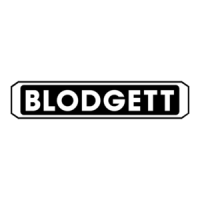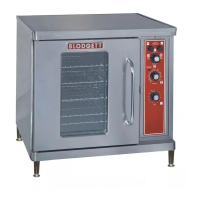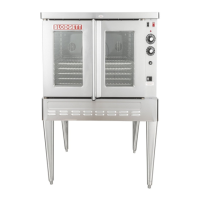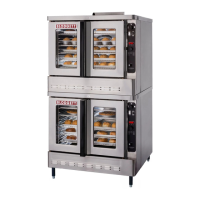OPERATION
2-10
CE APPROVED SOLID STATE DIGITAL - 33345 REV C
Component Reference
NOTE: Refer to FIGURE 5 page 2-11 for compoĆ
nent locations.
1. MODE SELECTOR SWITCH
2. DOOR SWITCH
3. TIME AND TEMPERATURE CONTROLLER
4. AXIAL FAN
5. CENTRIFUGAL SWITCH
6. CONVECTION FAN MOTOR
7. HIGH LIMIT SWITCH
8. HOT AIR ELEMENT CONTACTOR
9. HEATING ELEMENTS
10. 50 WATT LAMPS
11. LIGHT SWITCH
Operation
1. Turn the mode selector switch (1) to the cook
position. Power goes to one terminal of the
door switch (2), terminal J8 of the temperature
controller (3), and the axial fan (4). The main
blower fan starts. If a temperature is proĆ
grammed into the controller, the power goes
from J9 to the centrifugal switch (5) in the conĆ
vection fan motor (6).
2. If the doors are closed, the door switch (2)
should also be closed, sending power to the
common terminal of the time and temperature
controller (3). The relay on this controller should
be closed since a temperature has been proĆ
grammed into the controller. A circuit is made
between common and N.O. sending power to,
and starting the convection fan motor (6).
NOTE: The relay in the time and temperature
controller is not field repairable. If
diagnosed as defective, the entire
board must be replaced.
3. When the convection fan motor (6) reaches full
speed the centrifugal switch (5) closes sending
power to the high limit (7). If the high limit is
closed, power goes to the coil of the hot air eleĆ
ment contactor (8). When the contactor closes
power is sent to the heating elements (9).
4. The 50 watt lamps (10) only receive power when
the light switch (11) is activated.
NOTE: Turn the mode selector switch to cool
down to bypass the door microswitch. This
allows the convection fan motor to operate
even when the doors are open.
NOTE: The resistive values for the probes used in
this oven have descending temperature
coefficients. As the temperature increases
the resistive values decrease.
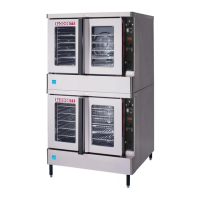
